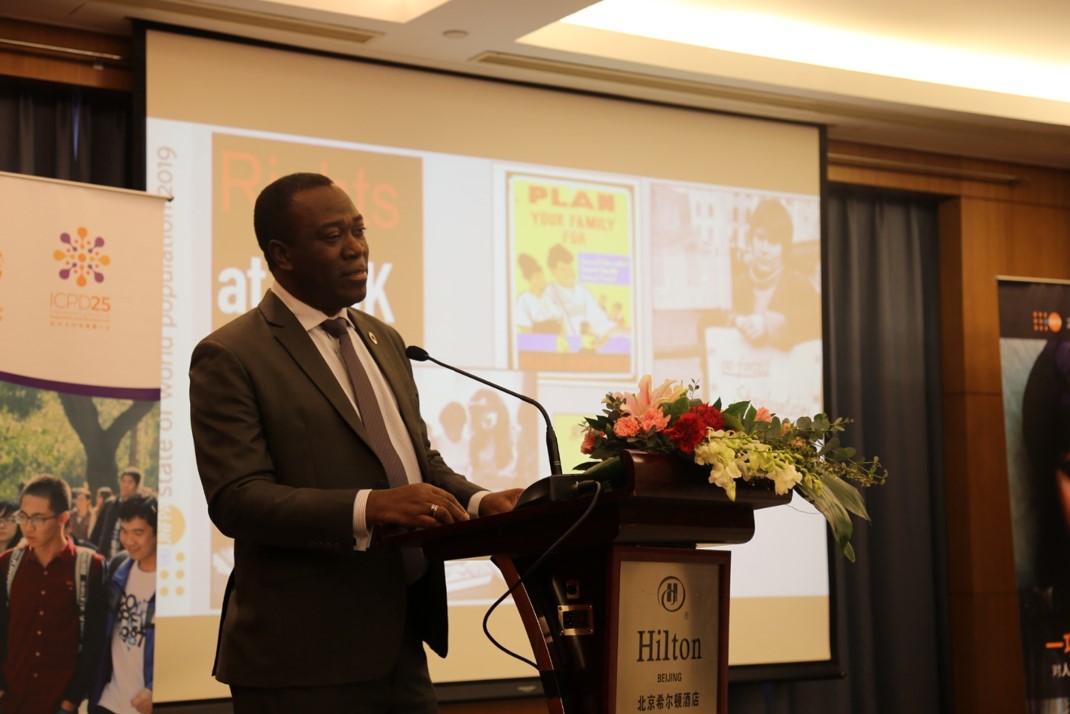UNFPA China and the Department of Population Monitoring and Family Development of National Health Commission jointly launched the 2019 State of the World Population Report titled “Unfinished business - the pursuit of rights of choices for all,”on 11 April 2019 in Beijing. Around 90 people from government institutions, think tanks, academia, NGOs, UN and international organizations, embassies, media, women and youth representatives participated.
The report traces advances in reproductive health on the anniversaries of several important milestones in both China and globally. It has been 50 years since UNFPA began its operations in 1969 to address population growth and reproductive health needs. It is also the 25th anniversary of the 1994 International Conference on Population and Development (ICPD), where 179 governments called for all people to have access to comprehensive reproductive health care. The year 2019 marks also 40 years of cooperation between UNFPA and China.
“Since its inception in 1969, UNFPA has led the multilateral effort to help women in developing countries to overcome socio-economic and cultural barriers to their reproductive rights and choices. The 2030 Agenda for Sustainable Development reinforces these principles with the aim to achieve universal sexual and reproductive health and rights by 2030,” said Mr. Nicholas Rosellini, UN Resident Coordinator in China at the opening of the launch event.

Dr. Babatunde Ahonsi, UNFPA Representative in China presented an overview of the 2019 State of World Population Report at the event. He called for joint efforts to reach the three zeros-zero unmet need for contraception, zero preventable maternal death, and zero violence or harmful practices against women and girls.
According to the report, much has been achieved since 1969. The average number of births per woman was 4.8 then, compared to 2.9 in 1994 and 2.5 today; fertility rate in the least developed countries dropped from 6.8 in 1969, to 5.6 in 1994 and 3.9 in 2019; and the number of women who died from pregnancy-related causes has decreased from 369 per 100,000 live births in 1994, to 216 in 2015. In addition, 24 per cent of women used modern contraceptives in 1969, compared to 52 per cent in 1994 and 58 per cent in 2019.
However, reproductive rights are still out of reach for too many women, including the more than 200 million women who want to prevent a pregnancy but cannot access modern contraceptive information and services.
Mr. Yang Wenzhuang, Director-General of the Department of Population Monitoring and Family Development of National Health Commission emphasized during the event that China has always been committed to the implementation of the ICPD agenda, and advocating for people-centered reproductive health and quality services, enabling individuals to make informed choices and achieving the sustainable development. He also said that China faces low fertility and rapid ageing, and shortage of sustainable resources such as water and arable land.
The report shows that in China, total fertility rate has dropped from 5.9 births per woman in 1969, to 1.7 in 1994 and 1.6 in 2019; maternal mortality ratio has been reduced from 77 deaths per 100,000 live births in 1994 to 27 in 2015; and 82 percent of married women used modern contraceptives in 2019, compared to 44 per cent in 1969. As a result of China’s rapid development, more women have attained higher education and entered into the labour force.
During the event, an intergenerational dialogue was held with five individuals aged from 21 to 65, who shared their personal stories on childbearing, work and life. While the 65-years-old Madam Liu Yinhua is helping with taking care of her two grandchildren, all the others (Ms. Shang Rong, Ms. Joanna Gong, Ms. Guo Yueping and Mr. Gu Yan) are still working or studying to pursue their personal aspirations and strive to balance work and life.
The discussions highlighted that in general, individuals and couples in China have access to reproductive health services, and they work and earn an income that allows them to realize their reproductive choices.
It also highlighted the need for more family friendly policies to increase gender equality in both the workplace and family. One of the barriers career women in China face is the tendency to spend more time than men on childcare and household management. Family friendly policies enable more equal sharing of domestic work and childcare between women and men so that both can fulfil their potential, according to the two commentators Professor Song Jian and Madam Feng Yuan.
On 10 April, the report was launched globally in Berlin, where the UNFPA Executive Director Dr. Natalia Kanem highlighted that, “we still have a long way to go before we can claim to have finished the business of the global reproductive rights movement”.
In November, the world will have a historic opportunity to reaffirm its commitment to complete the unfinished business of the ICPD at the Nairobi Summit on ICPD25 to be held in Kenya, where governments, activists and stakeholders will rally to protect the gains made so far, and fulfill the promise of the ICPD agenda.
Download the 2019 State of World Population Report:
English edition: https://china.unfpa.org/en/publications/190410
Chinese edition: https://china.unfpa.org/zh-Hans/publications/190410

